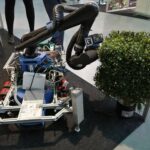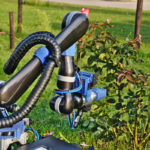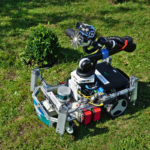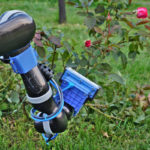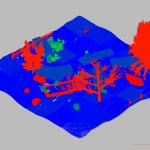The TrimBot2020 project has developed a vision-controlled robot for autonomous navigation and trimming of gardens, which works in
uncontrolled outdoor conditions without the need for active illumination or sensors. The robot navigates over varying terrain and approaches rose bushes and boxwood topiary, to trim them to an ideal shape. The platform is derived from the Bosch Indego robot lawnmower and is equipped with 5 pairs of stereo cameras that provide a 360 deg view.
It navigates using a user-defined garden map and 3D scene analysis and then visually servos to align itself to its trimming position next to the bush. Trimming of the bush is done using a novel electric plant cutter attached to the Kinova Jaco arm, which is mounted on the platform. Trimming occurs after scanning of the bush shape from an arm-mounted stereo camera. Two different actuators and control algorithms were designed for topiary bushes (rotating blades) and rose bushes (stem clipper).
Achieving this garden application required a combination of robotics and 3D computer vision research and innovation activities. Original developments in 3D sensing of semi-regular surfaces with physical texture (overgrown plant surfaces), coping with outdoor lighting variations, identifying different objects and types of surfaces, self-localising and navigating around obstacles, visual servoing to potentially moving target plants, leaves and branches, and innovative
engineering were required to deliver all this on a small battery-powered consumer-grade vehicle.
Coordinator
Robert Fisher
School of Informatics
Univ. of Edinburgh
1.26 Informatics Forum
10 Crichton Street
Edinburgh EH8 9AB
United Kingdom
Phone: (44)-131-651-3441 (direct line)
Phone: (44)-131-650-2685 (secretary)
Fax: (44)-131-651-3435


